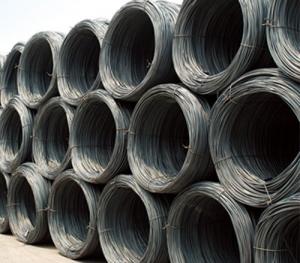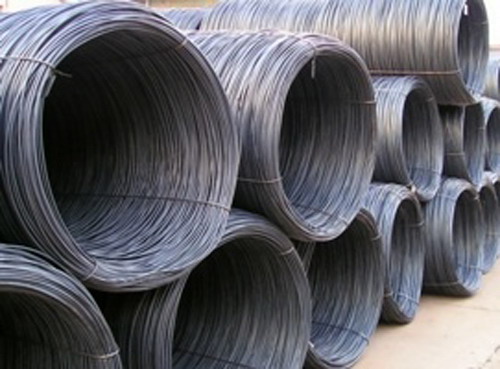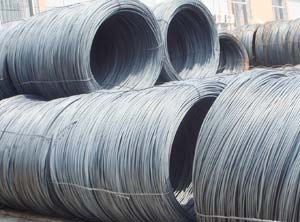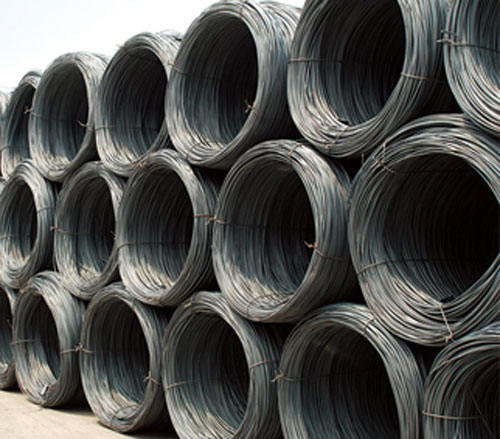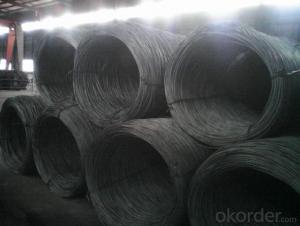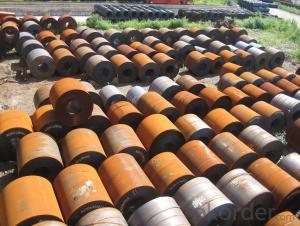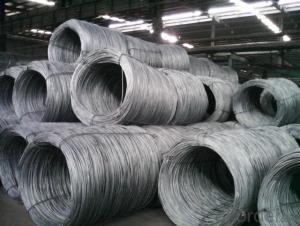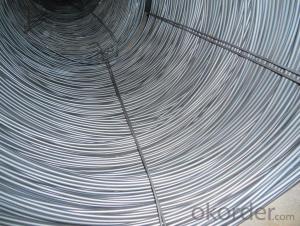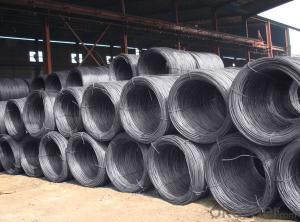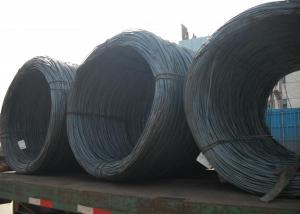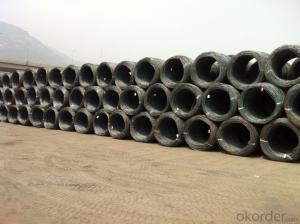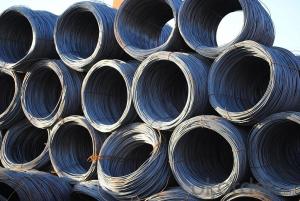Wire Rod SAE1012
- Loading Port:
- China Main Port
- Payment Terms:
- TT OR LC
- Min Order Qty:
- -
- Supply Capability:
- -
OKorder Service Pledge
OKorder Financial Service
You Might Also Like
Product Description:
Specifications of Hot Rolled Wire Rod:
Steel Grade: Q195/235, SAE1006-1018B Standard: ASTM, GB
Diameter: 5.5mm, 6.5mm, 7mm,8mm,9mm,10mm,12mm,14mm
Type: in coil, coil weight around 2MT Alloy or Not: Alloy
Technique: Hot Rolled Place of Origin: China Mainland
Surface: round, no twisted, light and smooth Brand Name: HSKY
Chemical Composition: (Please kindly find our chemistry of our material based on Q195、Q235A and Q235B as below for your information)
| Trademark | Rank | Chemical composition (quality score) % | ||||
| C | Si | Mn | S | P | ||
| ≤ | ≤ | ≤ | ||||
| Q195 | 0.06-0.12 | 0.30 | 0.25 | 0.050 | 0.045 | |
| Q235 | A | 0.14-0.22 | 0.30 | 0.30-0.65 | 0.050 | 0.045 |
| Q235 | B | 0.12-0.20 | 0.30 | 0.30-0.70 | 0.045 | 0.045 |
Usage and Applications of Hot Rolled Wire Rod:
After hot-rolled the products shaped into coil and delivery as finished product, including round, square, rectangular, hexagonal and so on. Since most of the products are round, it is generally called wire rod. Carbon steel wire rod is widely used in construction and manufacturing. Carbon steel wire rod is mainly used for reinforcement of reinforced concrete and welded structure or reprocessed (roberts , nail, etc.) materials, especially used to produce wire drawing, welding electrode, nails, spring, electronic, precise machinery parts and so on.
Packaging & Delivery of Hot Rolled Wire Rod:
Packaging Detail: products are packed in coil, each coil weight around 2 MT, and then shipped by container or bulk vessel
Delivery Detail: within 45 days after received deposit or LC.
Label: to be specified by customer, generally, each bundle has 1-2 labels
Trade terms: FOB, CFR, CIF
- Q: What are the different types of steel wire rod surface cleaning methods for wire drawing?
- There are several types of steel wire rod surface cleaning methods for wire drawing. These include mechanical cleaning, chemical cleaning, and electrolytic cleaning. Mechanical cleaning involves the use of brushes, abrasive pads, or shot blasting to remove dirt, rust, and scale from the surface of the wire rod. Chemical cleaning involves the use of acids or alkaline solutions to remove contaminants and oxide layers from the surface. Electrolytic cleaning uses an electric current to dissolve and remove impurities from the wire rod surface. Each method has its advantages and suitability depending on the specific requirements of the wire drawing process.
- Q: How is steel wire rod used in the production of ropes?
- Steel wire rod is used in the production of ropes as it serves as the primary material for the core of the rope. The rod is typically twisted together with other wire strands to form a strong and durable rope structure. This core provides the necessary strength and stability to the rope, allowing it to withstand heavy loads and resist wear and tear. Additionally, steel wire rod can also be used as an outer layer or coating for ropes to enhance their tensile strength and corrosion resistance.
- Q: How is steel wire rod packaged for transportation?
- Steel wire rod is typically packaged for transportation in a variety of ways, depending on the specific requirements of the customer and the mode of transportation being used. One common method of packaging steel wire rod is by using coils. The wire rod is wound tightly around a central core, creating a coil that is easy to handle and transport. These coils can vary in size and weight, depending on the specific needs of the customer and the transportation method being used. Coils are often wrapped in protective materials, such as plastic or paper, to prevent damage during transportation. In addition to coils, steel wire rod can also be packaged in bundles. Bundles are typically made up of a certain number of individual rods that are securely bound together using straps or wire. This type of packaging is often used for larger quantities of wire rod, as it allows for easier handling and loading onto trucks or shipping containers. Bundles are also typically protected with some form of wrapping material to prevent damage during transportation. When it comes to shipping steel wire rod internationally, it may be necessary to use containers for transportation. In this case, the wire rod can be loaded into containers either as coils or bundles, depending on the preference of the customer and the efficiency of loading and unloading at the destination. Overall, the packaging of steel wire rod for transportation is designed to ensure the safe and efficient delivery of the product to the customer. It takes into account factors such as the quantity of wire rod being transported, the mode of transportation being used, and the specific requirements of the customer. By using coils, bundles, or containers, steel wire rod can be securely packaged for transportation, minimizing the risk of damage and ensuring the product arrives in its desired condition.
- Q: How is steel wire rod used in the production of wire harnesses?
- Steel wire rod is an essential component in the production of wire harnesses. Wire harnesses are used in various industries, including automotive, aerospace, and electronics, to connect and organize electrical wires and cables. Steel wire rods serve as the base material for manufacturing the wires used in wire harnesses. These rods are typically made from carbon steel and go through a series of processes to transform them into wires of various thicknesses and diameters. The wire rods are first cleaned and coated with a lubricant to enhance their durability and flexibility. Once the wire rods are prepared, they are drawn through a series of dies to reduce their diameter and increase their length. This drawing process helps in aligning the steel molecules, making the wires stronger and more uniform. The drawn wires are then annealed to relieve internal stresses and further enhance their ductility. The resulting steel wires, which are now smooth and uniform, are then used in the production of wire harnesses. These wires are cut to the required lengths and stripped at specific points to expose the conductive metal. The stripped ends are then soldered or crimped to connectors, terminals, or other electrical components. The wires are then bundled together using various techniques, such as braiding, taping, or plastic molding, to form the final wire harness. Steel wire rods play a crucial role in the production of wire harnesses as they provide the necessary strength and conductivity required for efficient electrical connections. The quality and properties of the steel wire rod directly impact the performance and reliability of the wire harnesses, making it essential to use high-quality materials in their production.
- Q: How is steel wire rod used in the manufacturing of wire forms for automotive exhaust systems?
- The manufacturing of wire forms for automotive exhaust systems heavily relies on steel wire rod. These wire forms are essential for providing structural support and stability to the exhaust system, ensuring its optimal functioning and long lifespan. To begin with, steel wire rod is employed to construct the primary framework of the wire form, which serves as the backbone of the exhaust system. This framework is responsible for securely holding and positioning various components of the exhaust system, including the muffler, catalytic converter, and pipes. The remarkable tensile strength and durability of steel wire rod make it an ideal choice for this purpose, as it can withstand the intense vibrations, heat, and pressure that the exhaust system encounters. Furthermore, steel wire rod is utilized to shape the hangers and brackets that fasten the exhaust system to the vehicle's chassis. These hangers and brackets are crucial for maintaining the correct alignment and stability of the exhaust system, preventing any unnecessary movement or rattling. The flexibility and malleability of steel wire rod enable it to be easily formed into the desired hanger or bracket design, ensuring a precise fit and dependable performance. Moreover, steel wire rod is also employed in the fabrication of wire mesh screens and filters that are installed within the exhaust system. These screens and filters play a vital role in trapping and eliminating contaminants, such as particulate matter and harmful gases, from the exhaust gases before they are released into the environment. The exceptional strength and corrosion resistance of steel wire rod make it an excellent choice for constructing these screens and filters, as they must endure harsh operating conditions and exposure to corrosive elements. In conclusion, steel wire rod plays a critical role in the manufacturing of wire forms for automotive exhaust systems. Its impressive tensile strength, durability, flexibility, and corrosion resistance make it the ideal material for constructing the main framework, hangers, brackets, and screens/filters within the exhaust system. By utilizing steel wire rod, manufacturers can ensure that the wire forms provide the necessary structural support, stability, and reliability required for the proper functioning of automotive exhaust systems.
- Q: How is steel wire rod used in the manufacturing of wire for elevator counterweights?
- Steel wire rod is used in the manufacturing of wire for elevator counterweights as it provides the necessary strength and durability to support the weight of the elevator. The wire rod is carefully shaped and customized to meet the specific requirements of the counterweights, ensuring optimal performance and safety.
- Q: What are the common industry skills for steel wire rod distributors?
- Some common industry skills for steel wire rod distributors include knowledge of steel products and specifications, understanding of market trends and customer needs, strong sales and negotiation abilities, effective communication and relationship-building skills, proficiency in supply chain management and logistics, and the ability to analyze and interpret technical data related to steel wire rods.
- Q: What are the different types of steel wire rod surface inspection techniques?
- There are several types of steel wire rod surface inspection techniques, including visual inspection, magnetic particle inspection, ultrasonic testing, eddy current testing, and dye penetrant inspection.
- Q: What are the common production processes for seaborgium-coated steel wire rod?
- The common production processes for seaborgium-coated steel wire rod typically involve a series of steps. Firstly, the steel wire rod is cleaned and prepared to ensure a smooth surface. Then, a layer of seaborgium is applied onto the surface of the wire rod using techniques such as physical vapor deposition or electroplating. This is followed by a curing process to ensure proper adhesion and durability of the seaborgium coating. Finally, the coated wire rod undergoes quality control checks and is then ready for further usage in various applications.
- Q: How are steel wire rods used in the production of wire ropes for cranes?
- Wire ropes for cranes heavily rely on steel wire rods, which act as a crucial ingredient. These rods function as the primary material in the wire rope manufacturing process. Initially, careful selection of steel wire rods is based on their mechanical properties, such as strength and durability. Subsequently, a sequence of processes, including cleaning, heating, and drawing, is applied to transform the rods into wire strands. After the formation of wire strands, they are tightly wound together to create the wire rope. This procedure entails intertwining numerous strands around a central core, typically composed of fiber or steel. The arrangement of the wire strands in a helical pattern enhances both the strength and flexibility of the wire rope. The steel wire rods specifically chosen for the production of wire ropes for cranes possess high tensile strength. This ensures that the wire ropes can endure heavy loads and extreme working conditions. The strength of the steel wire rods directly impacts the overall strength and safety of the wire ropes. Moreover, during the manufacturing process, the steel wire rods undergo various quality control measures to ensure their dependability and consistency. These measures entail testing for tensile strength, breaking load, and other performance parameters. Once the wire ropes are manufactured using the steel wire rods, they find utility in a wide range of crane applications. Wire ropes are indispensable for lifting and transporting heavy loads, providing stability and control throughout crane operations. They play a critical role in the secure and efficient lifting, lowering, and suspension of loads in diverse construction, industrial, and maritime settings. In conclusion, steel wire rods are an essential part of wire rope production for cranes, as they deliver the necessary strength, durability, and reliability required in demanding work environments.
Send your message to us
Wire Rod SAE1012
- Loading Port:
- China Main Port
- Payment Terms:
- TT OR LC
- Min Order Qty:
- -
- Supply Capability:
- -
OKorder Service Pledge
OKorder Financial Service
Similar products
Hot products
Hot Searches
Related keywords
